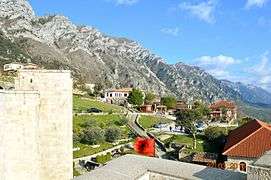Durrës County
The County of Durrës (Albanian: Qarku i Durrësit; pronounced [caɾkˈu i durəˈsit]) is one of the constituent counties in the northwest of Albania. It borders the counties of Dibër, Lezhë, Tirana and the Adriatic Sea.
County of Durrës Qarku i Durrësit | |
|---|---|
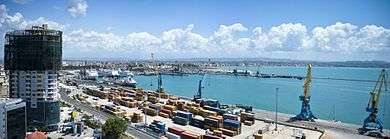 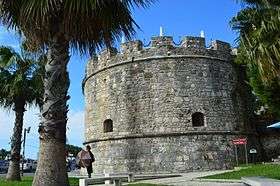 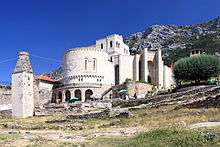 .jpg) 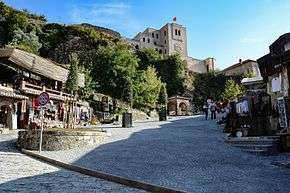 Clockwise from top: Port of Durrës, Durrës Castle, Skanderbeg Museum, Krujë Bazaar, Antea Cement Factory and the City of Krujë. | |
 Flag  Emblem | |
 | |
| Coordinates: 41°30′N 19°35′E | |
| Country | |
| Incorporated | Northern Albania |
| Seat | Durrës |
| Subdivisions |
|
| Government | |
| • Council chairman | Alfred Mullaraj (PS) |
| Area | |
| • Total | 766 km2 (296 sq mi) |
| Area rank | 12 |
| Population (2020[1]) | |
| • Total | 290,697 |
| • Rank | 3 |
| • Density | 380/km2 (980/sq mi) |
| Time zone | UTC+1 (CET) |
| • Summer (DST) | UTC+2 (CEST) |
| NUTS Code | AL012 |
| Website | Official Website |
The county has geographically a coastline on the Albanian Adriatic Sea Coast and extends in the Western Lowlands on a flat alluvial and coastal plain. The east is characterised by the Skanderbeg Mountains which splits the Western Lowlands from the Central Mountain Range. Its climate is profoundly determined by its proximity to the Mediterranean Sea and its considerable change in terrain.
The central city Durrës is one of largest cities on the Adriatic Sea and ranks 5th with a population of 175,110 and one of the world's oldest continuously inhabited cities.
Durrës is home to Albania's main port, the Port of Durrës. The port is also the 10th largest cargo port on the Adriatic Sea that handle more than 3.4 million tonnes of cargo per year.
The historical city of Krujë is the second largest city in Durrës County.
Geography
Durrës County is located in the North-Western part of Albania. It borders to the sea Adriatic Sea in the west. The climate is generally Mediterranean but varies by local topography. There are diverse microclimates in the county. Summers are dry while heavy rains are experienced during the winter.
The city of Krujë is found at an altitude of 600 m (1,969 ft) on the foot of Mount Krujë (Albanian: Mali i Krujës) of the Krujë Gorge, while south and west of the town is found the plain of the Ishëm River.[2] The town is located in the northern part of the outer Albanides tectonic unit, which consists of anticlines of Mesozoic carbonate platforms.
The Ishëm is the biggest river in Durrës County, it brings water to the area north of the Albanian capital, Tirana. It forms part of a watercourse (Tiranë - Gjole - Ishëm), but only the lower third of the watercourse is known as the Ishëm. Durres plain is divided by Tirana by long range of hills known as the Kodra e Gjatë to the east of the port city.
The Cape of Rodon is a rocky cape on the Adriatic Sea north of Durrës. On the Cape is the Rodoni Castle, built by Skanderbeg in 1463 and a Saint Anthony Church.
Politics
As of 2009, there are 13 representatives of Durrës County with setas in the Parliament of Albania out of 140.
Administrative divisions
Until 2000, Durrës County was subdivided into two districts: Durrës, and Krujë. Since the 2015 local government reform, the county consists of the following 3 municipalities: Durrës, Krujë and Shijak.[3] Before 2015, it consisted of the following 16 municipalities:
The municipalities consist of about 115 towns and villages in total. See Villages of Durrës County for a structured list.
Demographics
According to the last national census from 2011 this county has 262,785 inhabitants. Ethnic groups in the county include:[4]
Islam is by far the largest religion in the county, forming 67.46% of the total population (177,274 people). There are also some Bektashi Muslims with 1.60% (4,215 people), 3.47% percent consisting of believers without a denomination (9,131 people) and Christians forming 4.53% of the county's population (Orthodox (3.30%) (8,675 people), Evangelists (0.12% (325 people) (and Roman Catholics) (1.15%) (3,022 people).
References
- "Popullsia e Shqipërisë". instat.gov.al (in Albanian and English). 12 June 2020. Archived from the original on 12 June 2020.
- Gibb p.285
- "Law nr. 115/2014" (PDF). Archived from the original (PDF) on 2015-09-24. Retrieved 2015-06-03.
- "2011 census results" (PDF). Archived from the original (PDF) on 2016-03-04. Retrieved 2018-05-15.

